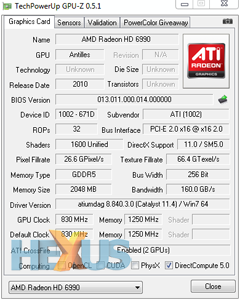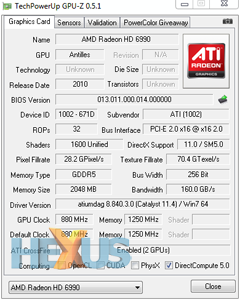Table of Doom
| GPU | Radeon HD 6990 OC 4,096MB | Radeon HD 6990 4,096MB | Radeon HD 6970 2,048MB | Radeon HD 6950 2,048MB | Radeon HD 5970 2,048MB | Radeon HD 6870 1,024MB | NVIDIA GeForce GTX 580 1,536MB | NVIDIA GeForce GTX 570 1,280MB | NVIDIA GeForce GTX 480 1,536MB |
|---|---|---|---|---|---|---|---|---|---|
| Transistors | 5.28bn | 5.28bn | 2.64bn | 2.64bn | 4.3bn | 1.7bn | 3.0bn | 3.0bn | 3.0bn |
| Die size | 2 x 389mm² | 2 x 389mm² | 389mm² | 389mm² | 2 x 334mm² | 255mm² | 520mm² | 520mm² | 529mm² |
| GPU | Cayman | Cayman | Cayman | Cayman | Cypress | Barts | Fermi v2 | Fermi v2 | Fermi |
| General clock | 880MHz | 830MHz | 880MHz | 800MHz | 725MHz | 900MHz | 772MHz | 732MHz | 700MHz |
| Shader clock | 880MHz | 830MHz | 880MHz | 800MHz | 725MHz | 900MHz | 1,544MHz | 1,464MHz | 1,401MHz |
| Memory clock | 5,000MHz | 5,000MHz | 5,500MHz | 5,000MHz | 4,000MHz | 4,200MHz | 4,008MHz | 3,800MHz | 3,696MHz |
| Memory interface | 256-bit x2, 4,096MB GDDR5 | 256-bit x2, 4,096MB GDDR5 | 256-bit, 2,048MB GDDR5 | 256-bit, 2,048MB GDDR5 | 256-bit x2, 2,048MB GDDR5 | 256-bit, 1,024MB GDDR5 | 384-bit, 1,536MB GDDR5 | 320-bit, 1,280MB GDDR5 | 384-bit, 1,536MB GDDR5 |
| Memory bandwidth | 2 x 160GB/s | 2 x 160GB/s | 176GB/s | 160GB/s | 2 x 128GB/s | 134.4GB/s | 192.4GB/s | 152GB/s | 177.4GB/s |
|
Geometry |
2 | 2 | 2 | 2 | 1 | 1 | 4 | 4 | 4 |
|
DP speed |
1/4 | 1/4 | 1/4 | 1/4 | 1/5 | NA | 1/4 | 1/4 | 1/4 |
| Shaders | 3,072 | 3,072 | 1,536 | 1,408 | 3,200 | 1,120 | 512 | 480 | 480 |
| GFLOPS | 5,407 | 5,099 | 2,703 | 2,253 | 4,640 | 2,016 | 1,581 | 1,405 | 1,345 |
| Texturing | 192ppc
bilinear 96ppc FP16 |
192ppc
bilinear 96ppc FP16 |
96ppc
bilinear 48ppc FP16 |
88ppc
bilinear 44ppc FP16 |
160ppc
bilinear 80ppc FP16 |
56ppc
bilinear 28ppc FP16 |
64ppc
bilinear 64ppc FP16 |
60ppc
bilinear 60ppc FP16 |
60ppc
bilinear 30ppc FP16 |
| ROPs | 64 | 64 | 32 | 32 | 64 | 32 | 48 | 40 | 48 |
| ROP rate | 56.4 | 53.1 | 28.2 | 25.6 | 37.1 | 28.8 | 37.1 | 29.3 | 33.6 |
| GTexel/s INT8 | 168.96 | 159.36 | 84.48 | 70.4 | 116 | 50.4 | 49.4 | 35.1 | 42 |
| FP16 rate | 84.48 | 79.68 | 42.24 | 35.2 | 58 | 25.7 | 49.4 | 35.1 | 21 |
| Board power (TDP) | 450W+ | 375W | 250W | 200W | 244W | 151W | 244W | 219W | 250W |
| HDMI | 1.4a | 1.4a | 1.4a | 1.4a | 1.3a | 1.4a | 1.4a | 1.4a | 1.4a |
| Retail price | £550 | £550 | £280 | £225 | £500 | £175 | £390 | £265 | £200 |
More of the same
Now, the first aspect to appreciate here, if it isn't yet abundantly clear, is that the Radeon HD 6990 has two GPUs on one board, much like the erstwhile champ HD 5970. The two GPUs' architectural topology is identical to a Radeon HD 6970's. This means they're composed of what AMD terms as dual graphics engines and a newer core arrangement that goes by the name of VLIW4. The guts of each HD 6990 GPU take in the same 24 SIMD engines - home to 64 processing cores each - and four texture units per engine.
Do the math and this adds up to 1,536 cores and 96 texture units. Each GPU is connected to card-mounted memory via a revamped 256-bit interface through to GDDR5 memory, in this case 2GB per GPU. Don't worry if this technology simplification doesn't make a whole heap of sense to you, because it's explained in more detail on these pages.
Huh, two new GPUs?
So you've got literally a doubling of power when compared to an already-fast HD 6970? Not quite, folks, because AMD dials down the core, shader and memory frequencies a touch. Shipping at 830MHz core and 5,000MHz memory, on-paper specs indicate Radeon HD 6990's GPUs are slower than a regular HD 6970, though, of course, much faster when combined. Boo-hoo, you may say, because wouldn't it be nice to have two full-fat Cayman XT cores buzzing along, but keeping two such GPUs within sane power-draw levels is no easy task.
Indeed, AMD has done an admirable job in keeping the overall board power down to around 375W, which is 'only' 50 per cent higher than a single HD 6970. How? Well, HD 6990 has a more-aggressive version of PowerTune technology allied to screened GPUs that operate at high-ish frequencies with lower voltage - AMD says it needs 1.12V per GPU, compared with 1.175V for an HD 6970.
Take into account the near-perfect performance scaling of modern GPUs when placed in tandem via CrossFireX and the Radeon HD 6990 4GB is bred to be a performance monster. But AMD is understandably concerned with just what kind of silicon animal NVIDIA has up its sleeve with the GeForce GTX 590, due to be released within a couple of weeks, and has thus outfitted the Radeon behemoth with what we call the Switch of Awesomeness.
Radeon HD 6990 OC - Switch of Awesomeness
Remember the tiny switch present on Radeon HD 6950/70 cards? Its purpose is to enable a second BIOS to be loaded on to the card, usually for backup purposes, though it has been used by add-in board partners to provide two levels of performance from one card.
 |
 |
AMD is taking much the same tack with the HD 6990. Switch the PC off, flick the switch, and the card loads up a revised BIOS that pumps extra voltage through both GPUs - 1.175V vs. 1.12V - and increases frequency to 880MHz core. Sadly, though, the memory stays at a default 5,000MHz, thus making a Radeon HD 6970/50 hybrid of sorts.
It won't be lost on you that these speeds are pretty close to a standard Radeon HD 6970, meaning that the HD 6990 OC, for that's what it's called, almost turns into a two-GPU implementation of the fastest single-silicon card from AMD's performance stable. Look at the table again and the numbers corroborate this fact.
Burn, baby, burn
Enthusiasts may ask why AMD isn't running the card in this state at all times. Cranking up the voltage and frequencies has the undesirable side effect of pushing up power-draw to some 450W with PowerTune set to default levels. Heck, enthusiasts can tinker with settings such that the card pulls even more watts from the PSU, pounding the 12V line with gay abandon. Holy moly, Batman, that's a fire waiting to happen, right? So is AMD giving you a lifetime supply of dry ice, paying for an air-con unit to be installed in your house, or reversing global warming in an effort to keep the card cool? Not exactly.









